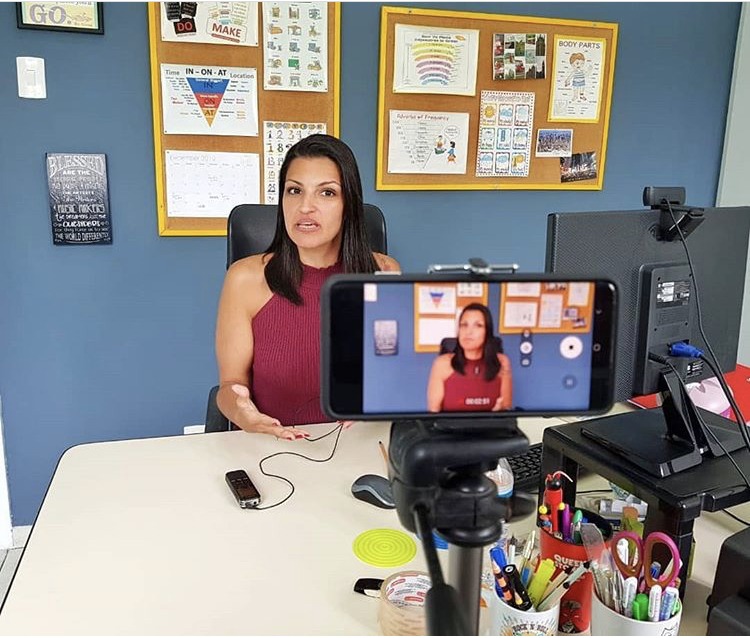Have you decided to become your own boss as an online English teacher? While going freelance or starting a teaching business gives you free rein over your work, it also requires you to hustle hard to reach as many potential students as possible. Traditional marketing tactics like paid ads or word of mouth still work, but you can also make yourself and your ESL classes visible to more people if you use social media to find online English students. We’ll explain why and how you can use seven strategies to attract new clientele as an English teacher.
If you’re new to teaching, you’ll want to get initial training and qualification with a TEFL certificate. You can explore our online TEFL courses to get started!
First, what social media platforms can I use to market myself as an online English teacher?
You’ve probably used at least one of these platforms to connect with your family and friends, but you can also benefit from each app’s features as a freelance ESL teacher.
Why should I use social media to find more online students as a freelancer?
Social media is used in some capacity by just about everyone in the world. Whether the platform is Facebook, Instagram, TikTok, Twitter, or LinkedIn, social media provides a place for people to connect personally or professionally, to be entertained, to get involved in a cause, and even to learn. As a teacher, you can leverage social media to connect with segments of this worldwide audience that are right for you.
Reach your target teaching niche
Tailoring your content helps you attract the niche you aim to teach. Hoping to get more teenage students? Post a fun English pronunciation video on TikTok and watch them come your way. Specializing in English certification exam prep? Post a tip on acing the IELTS on Facebook to attract test takers.
Learn more about the importance of finding your niche when teaching English online as a freelancer.
Build rapport
Using social media also lets you build rapport with future online students. For example, Bridge grad Carla Martinez is a Brazilian ESL teacher who has successfully marketed her tutoring services through various social network platforms. She says, “Giving social media users space to ask whatever questions they want has been a great way of creating trust and listening to what they actually need.”

Carla’s English grammar page on Instagram, @thesimplegrammar
Attract people’s attention
Anything that grabs social media users’ attention or interest – even if it’s just a grumpy cat or a joke – can easily make them stop scrolling through their feed. These interested viewers, after seeing a single post, often go straight to the source hoping to find more cool stuff.
As a freelance online English teacher, increasing your business’ visibility could be just one tap away. Who knows, your next student might be someone who checked out your English class Instagram profile because of a useful grammar tip you posted!
Get advice on how to find online ESL students.
How can I use social media to get more online English students?
From funny pictures to educational vlogs (video blogs), new types of content continually pop up in the online world. Here are some ways you can use social media to engage current ESL students or attract new ones.
1. Give English tips
Who says you can only study English through textbooks? Nowadays, ESL students get invaluable mini-language lessons through images or short videos on social media.
You might be surprised by how many people you can engage from the snippets of ESL info you share! For instance, Octavio Wilson, an English teacher in Chile, started sharing short, self-recorded videos about pronunciation on TikTok. After a couple of months, the number of followers he had on the app grew to 187,000! “Seeing a huge jump in followers was profoundly unexpected,” he says.

One of Octavio’s English pronunciation videos on TikTok
Aside from pronunciation, you can also share tips about vocabulary and grammar usage, useful expressions, and idioms on almost all social media platforms. You can make your posts attractive through colorful graphics, photos, and short videos – let your creativity fly!
2. Use humor, such as through memes
Many of us have laughed over a meme – a funny or witty text, picture, or video that users share online. Most of the time, memes use repeated images like cute dogs or something that’s currently trending, like Baby Yoda. The situations they describe vary greatly, from office work to coping with coronavirus lockdown. Of course, learning English can incorporate humor, too! Students can easily relate to a joke about struggling with pronunciation, for instance, or being shy to speak in English to native speakers!
In this article, freelance English teachers share their top strategies for finding ESL students.

A meme about pronouncing English words. Source: makeameme.org
3. Make vlogs
These days, you can find many ESL teachers who give lessons, answer English-related questions, and give useful advice through video blogs, or “vlogs,” posted on YouTube, Facebook, and Instagram TV. Bridge grad Carla, for instance, created YouTube videos to help Brazilian students overcome the hardships of learning English and answer their questions about grammar and studying.

One of Carla’s ESL vlogs on her YouTube channel
The sky’s the limit for the topics you want to talk about, from business English phrases to improving your fluency to understanding accents! However, with many other vloggers vying for users’ attention, you want to be as engaging as possible when it comes to presenting content, so don’t be afraid to add creative backgrounds, interview interesting people, or even do ESL role-plays in your vlogs. Remember, the goal of your vlogs is to get viewers hooked so they watch your videos until the end!
4. Showcase your digital badges
Instead of displaying a list of your ESL teacher credentials on your online profile, why not highlight your accomplishments visually by posting your digital badges? Digital badges are eye-catching and easier to read, plus their vivid colors can instantly make the pages of your Facebook, LinkedIn, and personal or business website look more appealing!

A Bridge digital TEFL/TESOL badge on LinkedIn
It’s also possible for people to click on these digital badges to get detailed information about the courses you took, thus saving you the time of writing descriptions of your certifications or specializations.
These 10 tips will help you attract and retain more students as a freelance online English teacher.
5. Join Facebook groups or discussion forums
Online groups, such as those on Facebook, are a place for people with common interests, such as travel, social justice, or language learning, to meet and share ideas. You can join English language learning groups or discussion forums on various social media platforms like Facebook and Quora, a popular question-and-answer site. As everyone in these groups is welcome to post, ask questions, and comment within the established rules, by joining the right groups, it won’t be difficult for you to connect with your target audience and market your English classes on their pages.
You can also create connections and expand your network by answering members’ questions, addressing concerns related to English, or offering to help them learn the language!
Join the Bridge Teaching English Online Facebook Group!
6. Organize real-time social media events
You can also invite potential learners to participate in a fun speaking activity that will stream live on Instagram, Facebook, and YouTube. This will not only allow them to practice English but also give them a glimpse of how you teach in a real online class!
Bridge grad Vera Baranovskaya took advantage of this live streaming feature when she organized the Speaking Club on Instagram. She explains that while it stemmed from the idea of helping her own English learners, it also helped her gain more students, saying “I had a person who once came to the Speaking Club because she wanted to improve her English. After the class, she told me, ‘It was so good! I enjoyed it so much and I want to have classes with you!'”

Vera’s Speaking Club on Instagram Stories
7. Create social media polls or surveys
Interact with your followers by getting them to participate in fun polls and surveys on Facebook or Instagram Stories. Engage your audience with questions such as what exactly they want to learn in English, for example, or get their opinion on the most effective strategies for learning the language. Afterward, you can post their responses and encourage other people to send in their replies too!
You can also use the poll or survey features to play a game related to English. Why not test their expertise on prepositions or knowledge in synonyms? You’ll never know if someone in your audience ends up taking classes because of something he learned from your online pop quiz!
Check out more ways to monetize your freelance teaching business.
How much does it cost to market my online ESL classes on social media?
Compared to online or print advertising, you don’t need to shell out a lot of money to market through social media! First, it’s free to sign up and create a business profile on many platforms. Instagram, for instance, offers a free business account that even comes with analytic tools for your account’s data, like profile clicks, reach, and individual post views.
Creating the content to post won’t break the bank either. Posting original text, images, and videos to your Facebook, Instagram, TikTok, LinkedIn, and other social media accounts is free (this is called organic content). These days, there are a lot of free apps available, such as Canva, to create high-quality graphics yourself, even if you don’t have a design background. You can also film videos in the comfort of your home using a quality smartphone camera and free video editing apps. Of course, you can invest in software and equipment when your social media marketing takes off.
If you want to boost your marketing game, you can opt to run a paid ad on social media, which doesn’t involve bank-breaking costs, contrary to popular belief. For example, on Facebook, it’s possible to set your budget for ads that you want to appear on the site, giving you control over costs based on what you can afford.

Carla filming her ESL videos for social media
While marketing on social media doesn’t necessarily make or break your English freelance work or business, it helps you grow your client base. You’ll need to put in a bit of hard work upfront and then keep your social media presence active, but your efforts will definitely result in getting more views, followers, and, most importantly, more online English students.












